Exploring the Lift Hydrofoil Board: A Guide
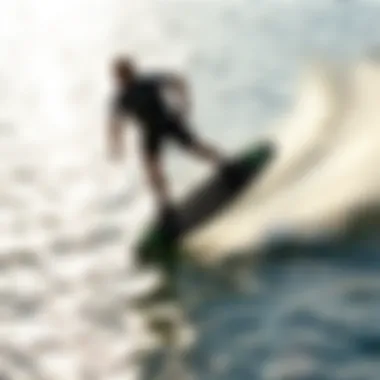
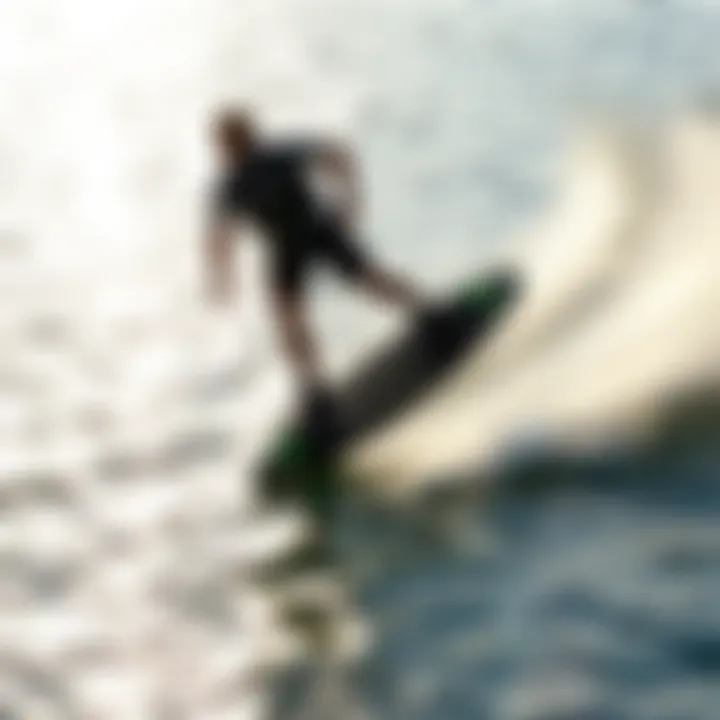
Intro
The world of kiteboarding has undergone a transformation in recent years, one that has captured the imagination of adventurers and thrill-seekers alike. Among the most innovative advancements is the Lift Hydrofoil Board. This watercraft not only enhances the performance of riders but also introduces a new layer of excitement to an already exhilarating sport.
Unlike traditional boards, which skim along the surface, hydrofoil boards lift above the water, gliding effortlessly through waves. For those new to the sport, this might seem complex. But fear not, as we will break down the mechanics in a way that even the greenest rider can grasp.
Kiteboarding enthusiasts will benefit from understanding the intricate design of the Lift Hydrofoil Board, the essential gear and equipment needed, and the techniques that can maximize the riding experience. This guide aims to be comprehensive, addressing safety considerations, practical tips for both novices and seasoned riders, and current trends within kiteboarding culture.
Get ready to tackle the nuances of this cutting-edge board and elevate your kiteboarding journey to greater heights.
Gear and Equipment
When it comes to kiteboarding, having the right gear can make all the difference. Choosing equipment that matches your skill level and riding style is vital. Let's explore what you need, starting from the basics for beginners to advanced gear for the seasoned kiteboarder.
Essential Kiteboarding Gear for Beginners
For those just getting their feet wet in the kiteboarding scene, certain pieces of equipment are non-negotiable. Here are the essentials:
- Kite: The heart of your kiteboarding experience. Opt for an inflatable kite, which is more stable and easier to control.
- Bar and Lines: This is how you control your kite. Ensure that you choose a bar with the right size for your kite.
- Harness: Comfortable and secure, the right harness can make or break your ride.
- Board: Look for a beginner-friendly board that provides good flotation and stability.
- Safety Gear: A helmet and impact vest are crucial for protecting yourself as you learn.
Every piece of gear plays its role, so don't skimp on quality. It'll pay off in the long run, trust me.
Advanced Equipment for Experienced Riders
For those who have honed their skills and are ready to take on more challenges, the world of advanced kiteboarding gear opens up. Here’s what you might consider:
- Hydrofoil Board: This is central to our topic—specifically the Lift Hydrofoil Board. This board allows you to ride above the water's surface, providing a unique experience.
- Custom Kite Sizes: Depending on wind conditions, having the right size can make a world of difference. Riders might want a quiver of kites.
- High-Performance Harnesses: Look for a harness designed for freestyle or wave riding for added support and comfort.
- Specialized Fins: These can enhance your maneuverability and provide a sharper edge when cutting through water.
Investing in the right advanced gear not only improves your performance but can also extend your thrill-seeking experiences.
Remember: Your equipment reflects your style—choose wisely to match your riding ambitions.
Next, we'll delve into the techniques and essential tips for both beginners and experienced riders. Not every day you get to elevate your skills like this!
Prologue to Hydrofoiling
In the world of water sports, hydrofoiling has carved out a niche that is both intriguing and exciting. This technique, which involves using a hydrofoil to lift a board above the water surface, transforms how riders experience water. It does not just add speed and agility; it also opens up a new realm of possibilities for creativity and expression on the water. Knowing about hydrofoiling is crucial for any kiteboarding enthusiast—it's a game-changer that can enhance your overall watercraft experience.
Hydrofoils allow riders to glide smoothly above the water, significantly reducing turbulence and drag. This has several benefits. For one, higher speeds can be reached with less effort. Moreover, because the board is elevated, it can traverse through choppy water conditions with greater stability and ease. The sensation of flying just above the water, free from the constant splash and bounce, adds an exhilarating layer to the sport.
Before delving into specifics about the Lift Hydrofoil Board, it is vital to grasp the fundamentals of hydrofoil technology. Understanding its components and how they function together lays the groundwork for a more profound appreciation of what makes this watercraft so appealing. Additionally, acknowledging the journey of hydrofoiling throughout its history provides valuable context for its current popularity and innovation in the recreational domain.
Learning about hydrofoiling not only improves your skills but gives you deeper insight into the technology and culture behind the sport.
Holistically, you can view hydrofoiling as a blend of science and art. The mechanics involved—how lift and drag interplay with each other—dictate performance. But embracing hydrofoiling also means recognizing the artistry in executing tricks and sculpting your style on the water. Engaging with this topic means embracing both mind and body, which is what makes an adventure worthwhile.
Overall, our dive into hydrofoiling technology, from its origins to its evolution in modern water sports, is sure to set the stage for a deeper understanding of Lift Hydrofoil Boards specifically. Understanding the nuances of this watercraft will inevitably enhance your kiteboarding experience, making each ride more fulfilling and enjoyable.
What is a Lift Hydrofoil Board?
In recent years, the lift hydrofoil board has captured the attention of water sports enthusiasts, especially kiteboarders. This innovative piece of equipment adds a unique twist to traditional kiteboarding, allowing riders to glide above the water's surface. Understanding what a lift hydrofoil board is entails not only grasping its purpose but also appreciating the design elements that make it distinctive.
A lift hydrofoil board comprises a mast, fuselage, wings, and the board itself, each serving a crucial role in the overall functionality of the setup. At its core, the board operates on the principle of hydrodynamics, leveraging lift generated by hydrofoils to reduce drag and enhance speed. As a result, riders can experience smoother rides and higher speeds compared to conventional boards.
Components of a Lift Hydrofoil Board
Mast
The mast is the vertical structure that connects the board to the hydrofoil assembly. Typically made from lightweight materials such as carbon fiber or aluminum, the mast supports the entire hydrofoil system. One prominent feature of the mast is its height, which can significantly affect performance. Longer masts allow for better lift and maneuverability, making them a favored choice for more experienced riders.
However, there is a trade-off; longer masts can be a bit more challenging to manage in choppy waters, particularly for novices. For those just starting, shorter masts provide a steadier balance, allowing for a more comfortable learning curve.
Fuselage
The fuselage links the mast to the wings, serving as the backbone of the hydrofoil assembly. Its length and stiffness are vital, as these factors directly influence stability and handling. A key characteristic of the fuselage is the ability to adjust the distance between the mast and wings, which can modify the board's performance.
A longer fuselage may enhance stability while sacrificing some agility. On the other hand, shorter fuselages can offer more responsive turns, appealing to riders who enjoy sharper maneuvers.
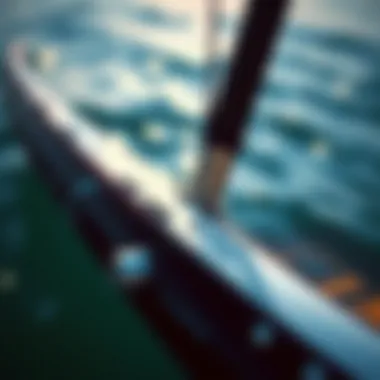
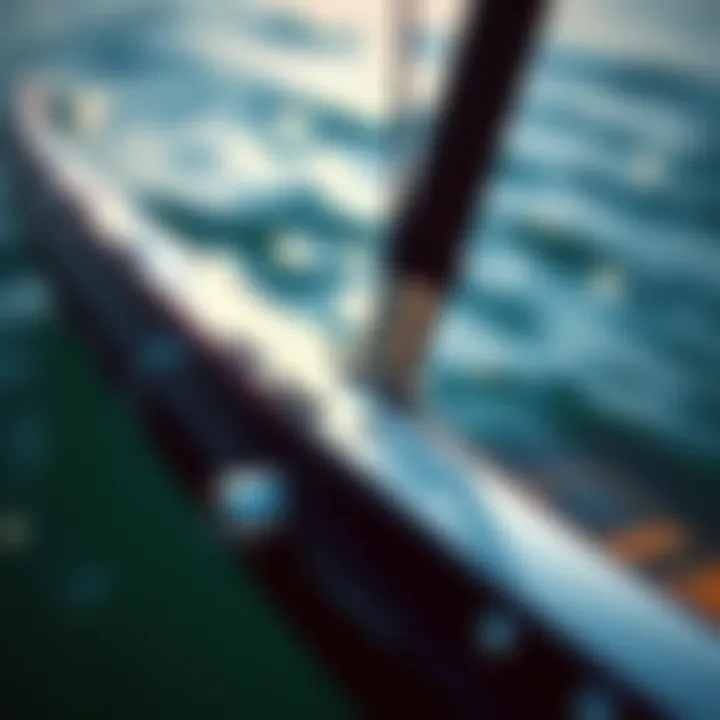
Wings
Wings are arguably the most critical component in this system. They generate lift as they move through water, allowing the board to rise above the surface. Various styles of wings exist, each suited to different riding conditions and styles. For instance, larger wings are beneficial for beginners, as they offer more lift and stability. Conversely, smaller wings allow for higher speeds and improved aerial maneuvers, making them suitable for advanced riders.
A unique feature of wings is their surface area and shape, which drastically affects how well the board performs in different conditions. While larger wings might make them more forgiving for novices, they can also introduce drag at higher speeds, requiring skill to optimize their function.
Board
The board itself is the platform on which the rider stands. Typically lightweight yet sturdy, lift hydrofoil boards come in varied shapes and sizes to accommodate different riding styles and preferences. A distinctive feature of these boards is their flat bottom, which aids in providing initial lift.
In choosing a board, riders often consider its width and volume; wider boards typically offer increased stability, while narrower ones can facilitate sharper turns. Additionally, the material and construction method influence durability and responsiveness, impacting overall riding experience.
Mechanics of Lift
Understanding how lift is achieved through hydrofoiling is fundamental for any rider. The interaction between the hydrofoil and water creates lift by redirecting water pressure. As the foil moves faster, the pressure above the wing decreases, while pressure below increases, resulting in lift that elevates the board above water.
This technological marvel significantly reduces drag, allowing riders to glide effortlessly. The ability to hydrofoil changes how riders engage with the water, transforming the way speed and movement are perceived in kiteboarding. Improvements in design and material technology continue to evolve, pushing the boundaries of what's possible on the water, ensuring that the lift hydrofoil board remains a crucial innovation in the world of kiteboarding.
Performance Features of Lift Hydrofoil Boards
Understanding the performance features of Lift Hydrofoil Boards is essential for kiteboarders seeking to elevate their experience on the water. The unique design and mechanics of these boards contribute not just to the thrill of riding, but to the overall efficacy in various conditions. Emphasizing elements like speed, stability, and weight can drastically affect performance and enjoyment during usage. Each characteristic not only influences how the board interacts with the water but also how the rider feels while maneuvering it, making awareness of these features crucial for both new users and seasoned pros alike.
Speed and Agility
Speed is often the crown jewel in water sports, and hydrofoiling presents an unprecedented avenue for achieving it. A Lift Hydrofoil Board lets riders swiftly glide above the water's surface, minimizing drag and providing an exhilarating sensation. When you’re on a hydrofoil, it feels like you’re flying just above the waves, cutting through the water with less resistance than traditional boards.
However, speed is not just about going fast; it’s about maintaining control during those high-speed runs. Agility becomes a significant factor; the ability to make tight turns and responsive movements can make all the difference during any session.
- Key Aspects of Speed:
- Lift and Glide: The hydrofoil’s lift reduces water contact, allowing for smoother transitions.
- Acceleration: Well-designed wings can increase speed significantly during take-off.
- Turning Speed: A more agile board permits sharper turns, essential for tricks and transitions.
Stability and Control
Stability on a hydrofoil can be a tricky subject, especially for those just starting out. Lift Hydrofoil Boards are designed for enhanced stability, which can make or break a ride. A good foil will sit balanced in the water, allowing the rider to focus on their technique instead of worrying about whether they’ll topple over.
Controlling a hydrofoil is an art. Many will find that the more practice they get, the easier it becomes to ride smoothly. Here’s what helps stabilize and control the board:
- Wing Design: Wider wings tend to offer more lift and stability.
- Fuselage Length: A longer fuselage can provide better tracking, making it easier to ride straight without constantly adjusting.
While it may take time to find true balance, proper equipment can certainly ease the learning curve, making every ride more enjoyable.
Weight Considerations
When selecting a Lift Hydrofoil Board, weight is a crucial factor not to overlook. Lightweight materials enhance performance and make a board easier to manage. If a board is too heavy, getting it airborne becomes more difficult, which could leave the rider frustrated instead of exhilarated. Using lighter materials like carbon fiber allows for a balance of strength and weight, ensuring durability without compromising performance.
- Things to Think About:
- Portability: A lighter board is easier to transport and handle, especially for those who plan to travel.
- Rider Weight: The weight of the rider impacts how the board performs. A board too heavy for a lighter rider might not function as effectively.
- Foil Weight: The weight of the entire setup, including the foil, affects the overall experience; a well-balanced setup can dramatically improve ride quality.
Overall, the performance features of Lift Hydrofoil Boards significantly influence the ride. From speed to stability and weight consideration, each factor plays a vital role in enhancing the user experience. Keeping these aspects in mind ultimately leads to a more constructive and enjoyable hydrofoiling adventure.
Advantages of Using a Lift Hydrofoil Board
The advent of hydrofoiling has transformed the landscape of kiteboarding, and understanding the advantages specifically associated with a Lift Hydrofoil Board is essential for any serious kiteboarding enthusiast. These advantages go beyond just being able to glide above the water; they encompass aspects of performance, efficiency, and the sheer joy of navigating the surf with finesse.
Efficient Movement on Water
One of the standout features of a Lift Hydrofoil Board is its remarkable ability to move efficiently on water. This efficiency can be largely attributed to the design of the hydrofoil, which allows the rider to experience a sensation akin to flying over the surface of the water.
Unlike traditional boards that require significant energy to maintain speed, the hydrofoil minimizes drag. The foils lift the board above the water, significantly reducing friction. When you hit that sweet spot of lift, it's as if you've been granted new wings. The result is that riders enjoy greater distances with less effort, making those long rides feel almost effortless, even in choppy conditions.
Moreover, this efficient movement means less wear and tear on both the board and the rider. Couple that with the ability to harness wind power effectively, and you'll find yourself gliding over the waves, almost whispering to the ocean beneath you.
Reduced Water Resistance
The hydrofoil design plays a critical role in minimizing water resistance. Unlike conventional surfboards that create significant drag, hydrofoils operate by displacing water in a way that diverts it around the wings. This process means that once you lift off, the board encounters much less resistance, thereby allowing for higher speeds with less energy output.
This reduction in resistance does not only affect top speeds; it also enhances overall stability. When you're skimming above the water, the elements that typically cause turbulence are less pronounced. In windy conditions or rough seas, the Lift Hydrofoil Board excels, giving the rider a smoother experience than traditional boards would.
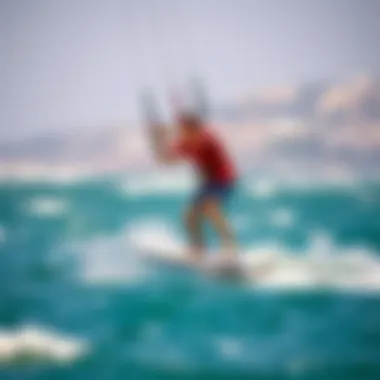
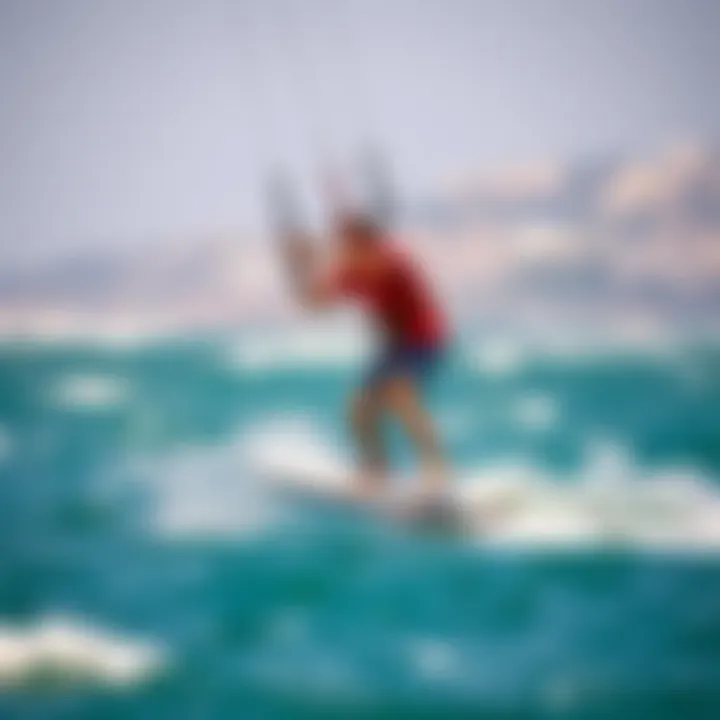
However, one should be cautious as this same stability can encourage faster speeds, which may require more advanced control skills. Nevertheless, for those willing to adapt, the rewards of riding on a Lift Hydrofoil Board are well worth the effort.
"The lift generated by the hydrofoil proves to be a game changer, turning the kiteboarding experience from mundane to exhilarating."
Safety Considerations for Hydrofoiling
Hydrofoiling is an exhilarating and innovative way to engage with water sports, but with great pleasure comes significant responsibility. Safety considerations are at the forefront for both novice and seasoned riders. Understanding the potential risks and how to mitigate them holds the key to having a safe and enjoyable experience on a lift hydrofoil board. As thrilling as gliding above the water may feel, the hazards associated with high speeds and the technical nature of the board require careful attention.
Proper Usage and Handling
Proper usage and handling of a lift hydrofoil board are paramount for maintaining safety on the water. It's not just about knowing how to ride; it involves an understanding of the board's mechanics and your environment. Before taking off, consider these vital points:
- Familiarize Yourself with the Board: Each board has unique specifications and responses. Spend time learning how it reacts in different conditions before pushing your limits.
- Choose the Right Conditions: Always check weather and wave conditions. For beginners, calm, flat waters are ideal until you gain confidence. High winds and rough waters can drastically increase the risk of accidents.
- Practice Falling Safely: Falling is part of the learning curve. When you do, try rolling away from the board to prevent injuries from impact.
- Proper Takeoff Techniques: Start slowly and gradually increase your speed. Learning how to balance and control your lift before hitting full throttle will save you from unexpected crashes.
Gear and Protective Equipment
Wearing the right gear and protective equipment is crucial for anyone venturing into hydrofoiling. Of course, accidents can happen, no matter how experienced you are. Here’s what you should consider:
- Impact Vest: A specially designed impact vest can provide additional buoyancy and protection to your torso during falls. It cushions impacts and can prevent serious injuries.
- Helmet: Protecting your head should be a non-negotiable priority. A certified hydrofoil helmet offers crucial protection from falls or collisions.
- Wetsuit: Besides keeping you warm, a wetsuit provides a layer of protection against scrapes and irritations from the board.
- Leash: A reliable leash keeps the board attached to you, preventing it from drifting away and reducing the chances of accidents where the board could hit other riders or swimmers.
"A well-prepared rider is a safe rider. Always prioritize safety gear."
Being equipped with the essentials doesn't just ensure your safety but also prepares you to enjoy the ride without fear. As you take to the waters, remember that understanding safety considerations doesn't just apply to yourself, but also to your fellow riders and the environment around you. This holistic approach to safety will go a long way in making hydrofoiling a rewarding experience for everyone involved.
Choosing the Right Lift Hydrofoil Board
Selecting the right Lift Hydrofoil Board is a crucial step for kiteboarding enthusiasts. A well-chosen board aligns with your skill level, intended use, and budget, catering to the unique needs of every rider. Understanding these factors not only enhances the overall experience but also ensures that one can perform safely and effectively on the water.
Factors to Consider
Skill Level
The skill level of a rider plays a significant part in choosing a hydrofoil board. For example, beginners usually benefit from a board that is more stable, as it provides a greater margin for error. A board designed for intermediate or advanced riders often allows for quicker maneuvers and higher speeds, but it can also lead to more wipeouts if the rider isn’t competent in handling such dynamics. Hence, a beginner might find joy in slower, more forgiving models like the Lift Foils Lift eFoil, while a seasoned pro might lean towards something like the Naish Hover.
- Key Characteristic: Beginners should look for boards with a larger surface area, as these boards tend to be more stable.
- Advantage: Increased awareness of every movement and confidence will develop faster.
Intended Use
When it comes to intended use, understanding what kind of riding you'll be doing shapes your decision greatly. Are you looking for a board primarily for cruising around leisurely, or do you have your sights set on performing tricks? Some boards, such as those in the Cabrinha range are specifically designed for tricks and jumps. Lightweight boards focusing on agility may not be as stable for long rides, thus making them a poor choice for leisurely settings.
- Key Characteristic: Identify if your primary focus is speed, performance, or stability to ensure you select a board that aligns with your riding goals.
- Unique Feature: Customizing your experience through different setups to adapt to your riding style and environment can greatly enhance enjoyment.
Budget
Budget considerations often dictate the scope of choices available. Entry-level boards commonly priced lower while providing foundational performance can still serve novices well. More premium models from brands such as Slingshot may offer advanced features and lighter materials, though at a steeper price. It’s wise to factor in not just the board’s initial cost, but also any necessary accessories like a quality harness or safety gear.
- Key Characteristic: Value for money becomes an essential criterion. It's not always about the priciest option; sometimes, a moderately priced board may meet the needs effectively.
- Advantage: Understanding your budget limitations allows for smarter purchasing decisions that contribute to long-term satisfaction.
Popular Brands and Models
Among the notable brands catering to hydrofoil enthusiasts, Lift Foils has carved out a special place due to its innovative approach to design. The Lift eFoil is recommended for its technological advancements. Another strong contender is Slingshot with its Wizard model that offers flexibility for various rider levels. For those more inclined towards classic hydrofoil experiences, the Naish range provides soulful boards which resonate well in tranquil waters.
Choosing wisely among these brands ensures an enriching experience, whether you're just starting or stepping up your game in freestyle maneuvers. Always remember the equation: the right board equals a happier ride.
Technique Tips for Beginners
Understanding the fundamentals of hydrofoiling can be daunting at first, especially for those new to the sport. However, proper technique is the cornerstone of a safe and enjoyable experience on a Lift Hydrofoil Board. Mastering the basics not only accelerates the learning process but also enhances your confidence. Ensuring a strong foundation in technique can prevent mishaps and promote a smoother ride, making every session more rewarding.
Getting Started on a Hydrofoil Board
Embarking on your hydrofoiling journey starts with the right mindset and gear. Here are a few essential tips for a smooth start:
- Select the Right Location: Begin in a calm, shallow area where the water is smooth. Avoid crowded places and choose a spot with minimal obstacles, which can significantly reduce the risk of injury.
- Wear Appropriate Gear: Don't skimp on safety. A helmet and impact vest or a personal flotation device are crucial. They offer protection if you wipe out, which is part and parcel of learning.
- Body Position is Key: Start with your feet hip-width apart and centered over the board. Keep your knees slightly bent. Your weight should hover around your center of balance, which is essential for maintaining control.
- Focus on Your Stance: When you’re ready to get up, look ahead and lean forward slightly. This keeps your nose up, reducing the chances of the board stalling or nose-diving.
It’s essential to practice these techniques persistently. In the beginning, you might feel clumsy, but over time it becomes second nature.
Mastering Basic Movements
As you gain comfort on your hydrofoil board, the next step is honing basic movements. The following elements are foundational to developing your skills:


- Getting Up: Start by finding your balance. Use a tow rope initially if it’s available, as it helps to pull you up while you maintain a stable position. Once you feel secure, begin to practice getting up by yourself.
- Learning to Balance: Once you're upright, find your balance. Shift your weight gently from heel to toe, while keeping your upper body stable. Picture yourself on a surfboard, balancing against the waves.
- Turning and Carving: Practice simple turns by shifting your weight and leaning slightly in the direction you wish to go. Start slow; once you feel confident, you can try carving deeper into the turn.
"Practice does not make perfect. Only perfect practice makes perfect." This adage rings particularly true in hydrofoiling. Repeatedly refining your technique leads to increased skill.
Ultimately, the path to proficiency in hydrofoiling is paved with patience and practice. Each session will bring you closer to mastering more advanced movements, like jumping and carving skillfully.
For more detailed information, consider checking out relevant resources like Wikipedia, and community discussions on Reddit. These can provide deeper insights and tips shared by experienced riders.
Advanced Techniques for Experienced Riders
As one delves deeper into the world of hydrofoiling, merely riding the board isn't enough for the seasoned wave-chaser. Understanding advanced techniques becomes crucial. Not only do they enhance performance, they also expand the horizons of what is possible on the water. Riders seeking thrills need to master these skills to fully utilize the lift hydrofoil's capabilities.
Managing Speed and Turns
Getting the hang of speed management is key for hydrofoil enthusiasts. It isn’t just about going fast; it’s about knowing when to throttle back to maintain stability, especially during turns. Control is the name of the game. When rounding a bend, speed should be decreased slightly to allow for a smooth transition without compromising lift.
Riders need to pay attention to body positioning. Leaning too far forward can create unnecessary drag, whereas leaning back might cause you to lose control. Finding that sweet spot where balance is achieved while keeping enough speed to maintain lift is an art. Here, the hydrofoil’s responsiveness plays a major role. A well-tuned board will allow for easier adjustments, enabling riders to carve beautifully through the water.
Performing Tricks on a Hydrofoil
Mastering tricks is what truly elevates an experienced rider above the rest. The aerial maneuvers and fluid movements add an extra layer of excitement to hydrofoiling.
Jumping
Jumping is a standout skill for anyone looking to impress. It involves using the lift generated by the foil to become airborne. A proper jump not only requires ideal timing but also a solid understanding of momentum. Riders need to compress their knees before launching off a wave and extend fully at the peak — timing is everything.
The key characteristic of jumping lies in its exhilarating nature and the visual appeal it carries. A well-executed jump can leave onlookers in awe. However, this skill isn't without its challenges. It requires practice to perfect the technique and manage landing safely. The advantages of jumping include the thrill and the chance to showcase creativity in the air, but the risk of injury is not to be taken lightly, reminding riders to focus on building up skills gradually.
Carving
Carving isn’t just about style; it’s highly functional for maintaining speed and flow. The essence of carving lies in making graceful, controlled turns while keeping speed. It’s accomplished by shifting weight and using the board's shape to your advantage.
Carving allows you to navigate through the water with a fluidity that feels like painting a masterpiece. The unique part about carving is how it integrates seamlessly with momentum — it adds a thrill without the necessity of jumping. However, while carving appears smooth, it demands precision and concentration. Understanding the dynamics of water and how the foil interacts with it is vital for mastering this technique. Carving’s advantages include smoother rides and heightened control, making it a foundational technique in hydrofoiling.
Maintenance and Care for Hydrofoil Boards
When it comes to hydrofoiling, a lot of focus typically goes to the rides themselves. However, proper maintenance and care for your Lift Hydrofoil Board can drastically enhance its lifespan and performance. Just like a car needs regular oil changes and tire checks, your hydrofoil also deserves a bit of tender care to keep it in tip-top shape. Caring for this sophisticated piece of equipment isn't just about aesthetics; it directly influences how well it operates on the water.
Cleaning and Storage Tips
Keeping your hydrofoil clean is an essential practice that shouldn’t be overlooked. Saltwater and sand can wreak havoc on the materials, leading to corrosion and wear over time. Here are some straightforward tips for cleaning and storing your board:
- Rinse After Use: Always rinse your board in fresh water after each session. This simple act removes salt, sand, and any debris that can cause damage.
- Dry Thoroughly: Make sure to dry your board thoroughly before storage. Any remaining moisture can lead to mold or corrosion, especially around the connections.
- Store in a Cool, Dry Place: When not in use, keep the board in a cool, dry place out of direct sunlight. Avoid leaving it in a hot car trunk or by the beach, where extreme temperatures can degrade the materials.
- Use a Board Bag: Invest in a padded board bag for storage and transport. It will protect against dings and scratches that can occur when moving the board around.
"A clean board makes for a smooth ride," as any seasoned kiteboarder will tell you.
Conducting Routine Inspections
Regular inspections play an integral role in ensuring your hydrofoil remains in excellent working condition. Checking for any wear and tear should become part of your routine, similar to how you’d check a bike before a ride. Be on the lookout for the following aspects:
- Check Connections: Ensure that all connections, like mast and fuselage, are tight and secure. Loose connections can lead to catastrophic failures while on the water.
- Look for Dings or Cracks: Inspect your board and foil for any visible dings or cracks. Even minor damages can worsen over time, leading to major issues.
- Examine the Foil: Assess the wings for any bending or deformation. A warped wing will affect lift and maneuverability, dampening your riding experience.
- Maintain Hardware: Regularly check screws and bolts for corrosion or loosening. It’s easier to replace a rusted screw than to replace an entire component.
By taking these proactive steps, you’ll guarantee not only a better performance when you’re out on the water but also extend the overall longevity of your hydrofoil board, ensuring it’s ready for countless adventures ahead.
For more information on equipment maintenance, you might find these resources helpful: Wikipedia on Kiteboarding and Britannica on Water Sports.
Keep in mind that taking care of your gear is just as important as mastering your skills. Be diligent with maintenance, and your hydrofoil will reward you with smooth glides and unforgettable experiences.
Future Trends in Hydrofoil Design
The exploration of future trends in hydrofoil design is crucial for several reasons. First, as the sport of kiteboarding and hydrofoiling evolves, so too do the materials and technologies that enable riders to enhance their experience on the water. The importance of keeping up with these trends cannot be overstated; they offer insights into how hydrofoils can become more efficient and easier to use. Moreover, understanding these advancements is essential for both newcomers and seasoned enthusiasts who seek to maximize their performance and enjoyment during every ride.
Innovations in Materials
One of the most significant developments in hydrofoil design is the innovation in materials. Traditional hydrofoils often made use of heavier metals or composites, which, while durable, could restrict maneuverability and overall performance. Today, manufacturers are introducing lighter materials such as carbon fiber and high-grade plastics that provide incredible strength-to-weight ratios. These materials not only reduce drag but also improve the overall lift efficiency of the board.
Additionally, flexible and durable synthetic materials are being utilized in the blades and fuselage structures. With lighter components, riders can experience quicker accelerations and better responsiveness. This can translate into higher speeds and smoother transitions, allowing riders to tackle waves or crisp flat-water surfaces more effectively.
"The material choice in hydrofoil construction can change a rider's entire experience on the water. It's not just about weight—it's about how the foil interacts with both the rider and the water."
Advancements in Performance Technology
Alongside material innovations, performance technology is progressing by leaps and bounds. One of the noteworthy advancements includes the integration of sensors and smart technology into hydrofoils. These devices can monitor various metrics, such as speed, altitude, and angle, giving users real-time feedback. This data can help riders refine their techniques and enhance their skills.
Moreover, advancements in wing design are constant. Engineers are experimenting with different shapes and sizes of wings, allowing for greater versatility in performance. For example, wings with a higher aspect ratio can provide better lift at lower speeds, making them ideal for beginners. Conversely, wings designed with a lower aspect ratio may suit experienced riders seeking speed and precision in sharp turns.















